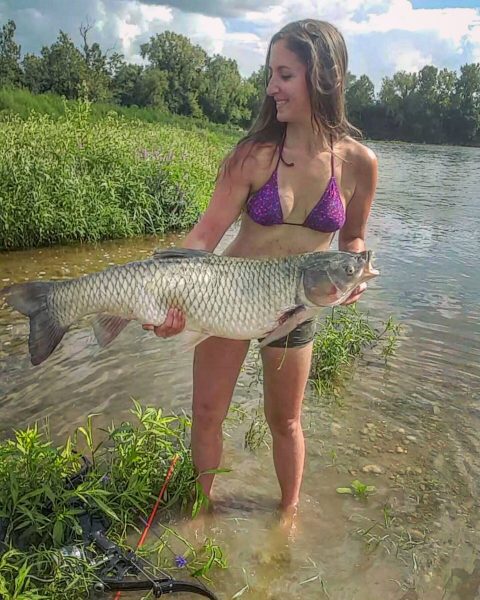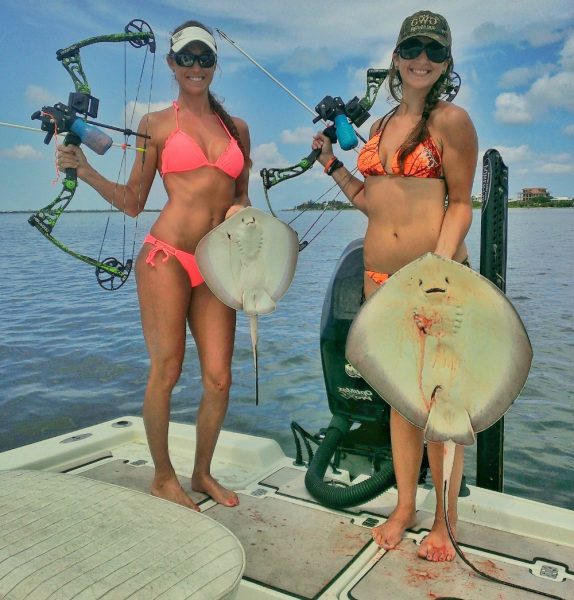Bowfishing’s Big 3
OutdoorHub Reporters 05.17.17

Bowfishing is an addictive sport – I’ve been hooked since I tried it several years ago. In fact, when it’s warm outside, I tend to spend more time at the river than I do at my house. Nothing beats a good day of mud, blood and fish slime!
In this article – my first of hopefully many as a contributor to OutdoorHub – I was asked by OHUB editors to write about my favorite three bowfishing species. Drumroll please . . .
#1. Longnose Gar
By far, my favorite species to target with a bow is longnose gar. These fish are easily recognizable with their prehistoric appearance and rows of razor-sharp teeth. They put on an awesome show when you shoot them, sometimes leaping clear out of the water at times.

Unlike bowfishing for some species of carp, you won’t experience good gar shooting year-round. Longnose gar spawn in late April through early June, swarming the banks and floating lazily on the water’s surface to soak in the sun. The fact that longnose gar have an air bladder and can breathe air – despite being a fish – makes it easy to spot them when they come up for a gulp of oxygen.
Longnose gar can grow up to 6 feet long and are pretty aggressive when arrowed. Their teeth, although razor sharp, have a tendency to snag on anything in their way. Several times I’ve had a tooth come out in my hand or arm while trying to remove my arrow. I’ve had bowfishing line cut during their attempts to free my arrow, and I’ve also learned to use sturdy bowfishing tips to pierce their tough scales without breaking.
Despite their attitude and gnarly appearance, these fish are actually great to eat. There are two strips of white meat on either side of their backbone (photo below). Cleaning them requires some effort to get through their armor-like scales – a hand saw and tin snips are my go-to tools. Fried up, gar meat is worth the effort; it has a texture similar to chicken. Important note: Be cautious when cleaning females though, because gar eggs are poisonous to mammals!

#2. Grass Carp
Runner up for my favorite fish to shoot is grass carp. They’re usually found in ponds and lakes, but on occasion they make their way to spots on the river. They tend to start showing up most often toward the end of summer. When they do, watch out . . . they’re going to be pretty good size. Not only will they put up an explosive fight while in the water, but they’ll tail-smack the daylights out of you when given a chance out of water. I have bruises to prove it.

I’ve lost more grass carp than I care to admit. Their bodies are extremely soft, and fish arrows tend to rip out easily, especially when it’s a big grass carp. I’ve been nearly dragged into the river, and come close to having my bow pulled out of my hands on several occasions. Having more than one shooter can up your odds of not losing a grass carp, but putting grapple tips with thick blades, such as the Kraken Point by Fin-Finder bowfishing, on your arrows will help as well.
After you hit a big grass carp, it’s best to try to move toward the fish as much as possible to create less tension on the line. I’ve found a heavier draw weight bow will give an arrow enough power to go through the carp’s thick body, and it will give you an advantage to reeling them in.

If you end up losing a grass carp during the battle, don’t give up just yet. Grass carp are territorial. If you see one in a particular spot, they will generally keep returning. I’ve hunted down several grass carp using this method.
#3. Stingrays
Although I’ve bowfished for stingrays only once in Florida, it was a rush I’ll never forget, so that’s why they sit in third place.
Similar to shooting grass carp, you need grapple tips to hold the weight of the stingrays so the arrow doesn’t rip out. I also learned the hard way that stingrays require a heavy line, and preferably gloves. After you hit a big one, you’re going to need to retrieve the line hand-over-hand, and once they settle themselves to the bottom of the ocean, it’s hard to get them to budge.

The crystal-clear water in Florida can make bowfishing stingrays trickier than you’d think. Seeing rays right next to the boat in clear water, they look like they are only a foot below the surface, when in reality they are several feet down. I missed my first one!
Once you get a stingray in the boat, you’ll need to beware of its tail whipping around. Their tails are equipped with one or two barbs that they use to sting predators. If stung, it can be deadly.
Stingrays are also great to eat. The wings can by cut up and fried, and the meat tastes like scallops.
Although these species made my top three, I’ll be honest – as long as I’m shooting fish with my bow, it doesn’t matter which species it is, I’m happy. Give it a try this spring! (See sidebar below for Beka’s gear tips.)

Sidebar: Gear Tips for the Big 3
When I first started bowfishing, all my equipment was hand-me-down . . . an old Browning youth model recurve, a metal Bear Archery hand reel from the 1960s, and the original Bear Archery arrows that tied off in several places.
Over the years, I’ve been fortunate enough to shoot, own and test various bowfishing rigs. As a bank shooter, it took me a while to find the perfect bow. I wanted high-quality gear that stood up to the dirt and fish slime; a bow that wasn’t too big and heavy to carry for hours; something relatively waterproof, and one that featured the appropriate draw weight.
The Poseidon Bow by Fin-Finder met all these standards, and it’s also extremely accurate and easy to shoot.
Although I don’t have a huge preference on reels (bottle reel vs. spincast), I currently shoot a Muzzy spincast reel. I’ve found spincast reels to be a bit faster, and I don’t have to worry about losing my line while walking.
Because I shoot a lot of carp and buffalo fish – soft-bodied fish – I’m a huge fan of grapple tip arrows. My current favorite is the Kraken Point by Fin-Finder; two mechanical blade-like barbs result in maximum holding power and fewer lost fish, which is always a good thing in my book! These fish points are also sturdy enough to pierce the armor-like scales of longnose gar. Give them a try!

